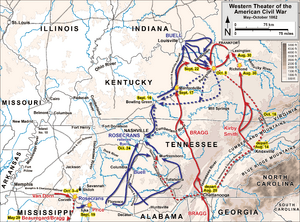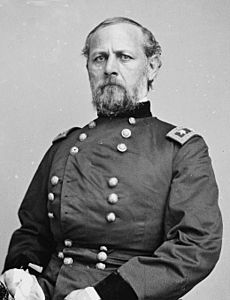Confederate Heartland Offensive facts for kids
Quick facts for kids Confederate Heartland OffensiveKentucky Campaign |
|
|---|---|
| Part of the Western Theater of the American Civil War | |

Map of Western Theater of the American Civil War, from Corinth, Mississippi, to Perryville, Kentucky
|
|
| Operational scope | Strategic offensive |
| Location | Tennessee and Kentucky 37°30′N 85°00′W / 37.5°N 85°W |
| Commanded by | |
| Date | August 14 – October 10, 1862 |
| Executed by | Army of Mississippi |
| Outcome | Union victory |
The Confederate Heartland Offensive (August 14 – October 10, 1862) was a major military plan during the American Civil War. It's also known as the Kentucky Campaign. Confederate Generals Braxton Bragg and Edmund Kirby Smith led this effort. Their goal was to get the state of Kentucky to join the Confederacy. They also wanted to move Union troops away from important areas.
Even though the Confederates won some battles, like the Battle of Perryville, they soon had to retreat. This meant Kentucky mostly stayed under Union control for the rest of the war.
Contents
Why the War Moved to Kentucky?
The Military Situation in 1862
In 1862, the Union army was doing well in the Western Theater. They had opened up important rivers like the Tennessee River and Cumberland River. This happened after winning battles at Fort Henry and Fort Donelson.
The Confederates also lost control of Corinth, a key railroad center. This meant much of western Tennessee was now controlled by the Union. New Orleans, a very large Confederate city, was also captured.
Why Kentucky Was Important
The city of Vicksburg, Mississippi became a top target for the Union. It was a strong Confederate base on the Mississippi River. Protecting Vicksburg was very important for the Confederates.
Confederate General Braxton Bragg came up with a plan. He wanted to draw Union attention away from Vicksburg. He also wanted to protect Chattanooga, Tennessee, which was being threatened. His idea was to invade Kentucky.
Kentucky was a "border state." This meant it was located between the Union and the Confederacy. It was a place where families were often divided, with some members fighting for the Union and others for the Confederacy. This was called "Brother against brother".
Kentucky had officially tried to stay neutral at the start of the war. But after a Confederate general occupied Columbus, Kentucky asked the Union for help. Many Kentuckians fought for both sides. About 125,000 Kentuckians joined the Union army. Around 35,000 Kentuckians fought for the Confederacy.
The Kentucky Campaign
In August 1862, General Braxton Bragg led his Confederate army into Kentucky. He hoped that people in Kentucky who supported the Confederacy would join his army. He also wanted to force Union General Don Carlos Buell and his troops to retreat.
Bragg moved his infantry (foot soldiers) by train from Tupelo, Mississippi to Chattanooga, Tennessee. His cavalry (soldiers on horseback) and artillery (cannons) traveled by road. By moving his army to Chattanooga, he was ready to challenge Buell's advance.
Once his army was in Chattanooga, Bragg planned to move north into Kentucky. He worked with Lt. Gen. Edmund Kirby Smith, who led another Confederate force. Smith's army was operating out of Knoxville, Tennessee.
Bragg's forces captured over 4,000 Union soldiers at Munfordville. Then, he moved his army to Bardstown. On October 4, he attended the event where Richard Hawes was named the temporary Confederate governor of Kentucky.
On October 8, a part of Bragg's army met Buell's Union army at Perryville. The Confederates won a tactical victory there. This means they won the battle itself, but it didn't lead to a larger strategic win.
After the battle, Kirby Smith urged Bragg to keep fighting Buell. Bragg said he would, but then he seemed unsure. He decided to order his army to retreat. They moved through the Cumberland Gap back to Knoxville.
Bragg called his retreat a "withdrawal." He saw it as the successful end of a large raid. He had several reasons for leaving Kentucky. He heard bad news from other battlefronts. He also felt his army had little to gain from another isolated victory. A defeat could cost him his army and all the supplies they had gathered. He wrote that he didn't want his army to be stuck in the cold north without tents or shoes.
What Happened Next?
The Outcome of the Invasion
The invasion of Kentucky was a strategic failure for the Confederates. Even though it forced Union troops out of some areas, the Union would regain that land later.
Some people thought the invasion was a success. Confederate General Joseph Wheeler said they got back important areas. He claimed the Confederates captured many cannons, weapons, and supplies. A Confederate clerk, J.B. Jones, wrote that Bragg got away with a huge amount of food and clothing. This included 8,000 beef cattle and 50,000 barrels of pork.
Who Was to Blame?
Bragg faced criticism from newspapers and even some of his own generals. However, many people shared the blame for the invasion's failure. Bragg and Kirby Smith's armies didn't work together under one clear command. Bragg could be blamed for moving his army away from a good battle spot at Munfordville.
Despite the criticism, Confederate President Jefferson Davis kept Bragg in command. Union President Abraham Lincoln removed General Buell from his command. Lincoln felt Buell was too slow in chasing Bragg. Buell was replaced by Major General William Rosecrans. Buell never led another army after this.
Bragg himself blamed the people of Kentucky. He had expected many Kentuckians to join his army. He even brought 20,000 extra rifles for new recruits. But he wrote that only about 2,000 men joined him, and half of them later left.
Buell's military career ended because he couldn't win a clear victory or effectively chase Bragg. He was investigated but found innocent of wrongdoing. Still, he didn't receive another command.





